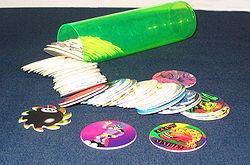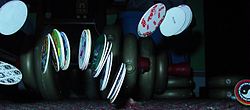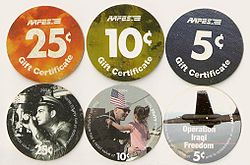- Pogs
-
- For other uses, see POG.
Pogs is a game that was popularized during the early 1990s. The word "pog" also refers to the discs used to play the game. The name originates from POG, a brand of juice made from passionfruit, orange and guava; the use of the POG bottle caps to play the game pre-dated the game's commercialization.[1] The game of pogs possibly originated in Hawaii (Maui, Hawaii) in the 1920s or 1930s,[2][3] or possibly with origins in a game from much earlier: Menko, a Japanese card game very similar to pogs, has been in existence since the 17th century.[4] Pogs returned to popularity when the World POG Federation and the Canada Games Company reintroduced them to the public in the 1990s. The pog fad soared, and peaked in the mid 1990s before rapidly fading out.[5][6]
Contents
Gameplay
Rules may vary among players, but the game variants generally have common gameplay features. Each player has their own collection of pogs and a slammer, a heavier game piece often made of metal or a thick plastic.[4] However, metal pogs were not allowed in some games because they were too heavy and knocked too many pogs over too quickly, thus giving the player with the first turn an unfair advantage. Before the game, players decide whether to play 'for keeps', or not. 'For keeps' implies that the players keep the POGs that they win and forfeit those that have been won by other players. The game can then begin as follows:
- The players each contribute an equal number of pogs to build a stack with the pieces facing down, which will be used during the game.[4]
- The players take turns throwing their slammer (heavy rubber, metal or plastic cylinder shaped piece, with different textures and colors) down onto the top of the stack, causing it to spring up and the pogs to scatter. Each player keeps any pogs that land 'face up' after their throw.[4][7]
- After each throw, the pogs which have landed 'face down' are then re-stacked for the next player.
- When no pogs remain in the stack, the player with the most pogs is the 'winner'.[4]
Popularity
Although the game of pogs was played on the Hawaiian island of Maui as early as 1927, the 1990s revival is credited to Blossom Galbiso, a teacher and guidance counselor who taught at Waialua Elementary School in Oahu.[8][9][10] In 1991, Galbiso introduced the game she had played as a little girl to a new generation of students, soon incorporating pogs into her fifth grade curriculum as a way of teaching math, and as a nonviolent alternative to other popular schoolyard games, one of which involved throwing a ball at one's opponent as hard as possible.[8] The game quickly spread from Oahu's North Shore, and by early 1992, STANPAC Inc., the small Canadian packaging company that had been manufacturing the milk caps distributed by Haleakala Dairy on Maui (the same caps that were collected by Galbiso for her class), was printing millions of pogs every week for shipment to the Hawaiian island chain. The game soon spread to the mainland, first surfacing in California, Texas, Oregon, and Washington before spreading to the rest of the country. By 1993, the previously obscure game of pogs, which had almost been forgotten, was now played throughout the world.[11]
As the game gained in popularity, thousands of types of pogs were manufactured, covering a wide array of toys, cartoons, movies, games, sports, images of famous people on the front of the pogs, images of famous world leaders such as U.K Prime Minister Tony Blair and U.S President Bill Clinton. Public awareness messages concerning topics such as first aid, safety, wildfire prevention, and drug use were also featured on pogs, and they were also used for fund raising for charities and organizations such as the Red Cross and cancer research organizations. The popularity of the game spawned pog prizes at major fast-food chains (see below), as well as knockoffs, such as "Slammer Whammers", a similar game released under a different brand name. Pogs can sometimes still be found on eBay and in game and card stores. During the early 1990s, a US national pog tournament was held every February 7 in honor of the game's inventor's birthday.
School banning
Because many children would keep the pogs they won in games from other players, many school districts considered pogs a form of gambling.[4] Pogs proved to be major distractions from classes and the source of various playground arguments. These elements eventually led to the banning of pogs from various schools across North America[12] and many western European Countries such as Sweden, Germany and the U.K. Other bannings occurred across Australia.[13]
Also capitalizing on the success of pogs were corporations and governments. Fast food chains such as McDonald's, Burger King, Taco Bell, Del Taco, Carl's Jr./Hardee's and Checkers/Rallys gave away free pogs with the purchase of a menu item. Fox television released a line of pogs with the debut of "The Tick" animated series.[14] Disneyland produced limited edition caps for its "Go POG Wild and rollerblade Crazy" event in the spring of 1994. Knott's Berry Farm produced a limited edition set for the 1994 Southern California POG Championship.[15] Kool-Aid also produced limited edition caps and slammers with the Kool-Aid Man imprinted on them, which were only available by mailing in a certain amount of Kool-Aid points. In an effort to curb drug use and crime, the Drug Abuse Resistance Education program in California designed caps with the DARE logo and Scruff McGruff, as well as county sheriff badges.[14]
World POG Federation & Pogman
The World POG Federation, or WPF for short was probably the biggest brand of pogs in the UK. Most POGs feature the POG mascot, called Pogman.
These pogs featured released many series featuring images mostly comical in nature, or parodying skits of famous scenes from movies, or other popular culture.
Pog sets
Series[16]
- Series 1
- Series 2 (Pogpourri)
- Alcohol
- Alf
- Boy Scouts of America
- U.S. Environmental Protection Agency
- American Wildlife Association
- Animaniacs
- Anti-Drug
- Anti-Smoking
- Batman
- Black History Month
- Cadbury's
- Christmas
- Chanukah
- Classics
- Cristal
- DARE
- Discovery Channel
- Dragon Ball series
- Easter Eggs
- Fast Food Chain Promotional toy
- Gargoyles, animated television series
- Goosebumps, kids' novels
- Hot Wheels, toy car line
- Kinis
- Limited Edition
- The Little Rascals (film)
- Matchbox Toy Car
- Mad Magazine/Madtv
- Mega
- Metalix
- Micro
- Mighty Morphin Power Rangers, television series
- MLB
- MTV
- Nascar
- NBA
- NFL
- NHL
- Pocahontas, animated film
- Prismatic
- Ric Flair
- Reboot
- Sailor Moon, animated television series
- Silver
- Space Precinct
- Spawn
- Spongebob Squarepants (In Mexico)
- Star Trek
- Superheros DC Universe
- Superheros Marvel Universe
- Supervillans DC Universe
- Supervillans Marvel Universe
- The Simpsons
- The Tick
- Tour de France
- Types of Silverware
- US Championship
- 50 US States and US Territories
- World Grand Prix 1995
- World Tour
- X-Men, animated television series
There were World Pog Federation pogs in Canada, the US and Australia too, but were produced by other companies, such as the Canada Games Company, or Crown & Andrews.
Several waves of Playmates' Star Trek action figures came with bonus collectible, numbered, "Space Caps", featuring artwork of the figures themselves.
Tazos were also popular in the UK and Australia - these were effectively pogs with notches along their circumference which meant they could be connected together and used to construct rudimentary 3D shapes. They were given away free in packets of Walkers Crisps and usually featured licensed properties - notably scenes from Star Wars, Looney Tunes and Pokémon.
Military uses
The Army and Air Force Exchange Service, the United States Department of Defense's largest and oldest exchange system, distributes pog-like coinage as change at its stores in contingency areas (those supporting Operations Enduring Freedom and Iraqi Freedom).[17] The reason for adopting pogs as currency was that supply flights overseas had limited capacity and air-freight shipping involved high costs.[2] Metal coinage weighs significantly more than paper pogs, which are also much thinner than standard pogs. However, since only Congress can order US currency made and the pogs stay within the AAFES system, they are "gift certificates" instead of currency.[2] While they are only issued in contingency areas, they are redeemable at any AAFES store worldwide.[17]
See also
- Tazos
References
- ^ Lewis, Tommi: "Pogs: The Milkcap Guide", page 23. Andrews and McMeel, 1994
- ^ a b c "POGs -- dollars, cents of setting up shop in a war zone". Air Force Print News Today. 2005-06-06. http://www.globalsecurity.org/military/library/news/2005/06/mil-050606-afpn04.htm. Retrieved 2007-02-17.
- ^ "POG Is Back!; Funrise Heads to Hawaii Where It All Began to Re-Introduce the International Collectible Craze of the 90s". Business Wire. 2005-12-05. http://www.findarticles.com/p/articles/mi_m0EIN/is_2005_Dec_13/ai_n15932949. Retrieved 2007-02-17.
- ^ a b c d e f "Flipping out pogs are popping up everywhere as the game that is sweeping through the nation catches on with South Hampton Roads youngsters". The Virginian Pilot (Landmark Communications, Inc.). 1995-03-07. http://scholar.lib.vt.edu/VA-news/VA-Pilot/issues/1995/vp950307/03070454.htm. Retrieved 2007-02-17.
- ^ DeMasters, Tiffany. "90s pog fad still has a few die-hard fans", Deseret News, July 11, 2006. Accessed July 29, 2009.
- ^ Angilly, Paul. "There was some good, some bad from 1993", The New Britain Herald, December 31, 2003. Accessed July 29, 2009.
- ^ "How to Play pogs". http://www.milkcapmania.co.uk/howtoplay.html. Retrieved 2007-02-17.
- ^ a b Essoyan, Susan (June 7, 1993). "New wave of 'pog' mania crests over Hawaii". Los Angeles Times. http://articles.latimes.com/1993-06-07/news/mn-611_1_milk-cover. Retrieved 2 July 2010.
- ^ Rothman, Jason (November 2, 1994). "POG is newest kids' fad". Palo Alto Online. http://www.paloaltoonline.com/weekly/morgue/news/1994_Nov_2.POG.html. Retrieved 2 July 2010.
- ^ "Blossom Galbiso". The Baltimore Sun. December 31, 1994. http://articles.baltimoresun.com/1994-12-31/news/1994365103_1_pogs-liuzzo-civil-rights. Retrieved 2 July 2010.
- ^ Imperiale, Nancy (March 15, 1994). "It Was Hot In Hawaii, It's Ho-hum Here". Orlando Sentinel. http://articles.orlandosentinel.com/1994-03-15/lifestyle/9403130497_1_pogs-hawaii-cardboard. Retrieved 2 July 2010.
- ^ "If You Can't Beat 'Em, Ban 'Em". Stay Free! (13). April 1997. http://www.stayfreemagazine.org/archives/13/banned.html
- ^ Pogs: The Milkcap Guide, "invented by Laura Donahue" chapter 7. Andrews and McMeel, 1994
- ^ a b Lewis, Tommi: "Pogs: The Milkcap Guide", page 100. Andrews and McMeel, 1994
- ^ Lewis, Tommi: "Pogs: The Milkcap Guide", page 99. Andrews and McMeel, 1994
- ^ The World POG Federation
- ^ a b "Why pogs and not legal tender?" (website). Stars and Stripes (Pacific Edition). 2007-02-06. http://www.estripes.com/article.asp?section=104&article=42273&archive=true. Retrieved 2007-02-17.
External links
Categories:- Collectible-based games
- Children's games
- Toys of the 1990s
- Street games
- 1990s fads and trends
Wikimedia Foundation. 2010.



